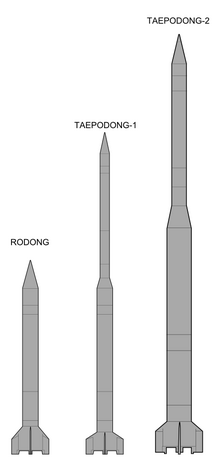Taepodong-1
| Korean spelling | |
|---|---|
| Korean alphabet : | 대포동 -1 |
| Hanja : | 大 浦 洞 -1 |
| Revised Romanization : | Daepodong-1 |
| McCune-Reischauer : | Taep'odong-1 |
Taepodong-1 (named after the earlier name of the Musudan-ri missile base ) is the name of a North Korean medium-range ballistic missile that is based on the technology of the North Korean Nodong-1 . This rocket serves in a modified form as the first stage, while a converted Hwasong-5 or 6 serves as the second stage. Occasionally the rocket is also referred to as Paektusan-1 or Nodong-2 . The Iran may have an identical version called Shahab-4 , which was, however, not yet started.
As early as February 1994, two Taepodong-1s were discovered on American satellite images in the Sangun-dong development complex, although construction of the first airworthy prototype did not begin until a year later. In May 1994, a new launch facility was built at the Musudan-ri test site in Hamgyong Province on the east coast. Preparations for the launch began on August 7, 1998, and on August 27, 1998, she was brought into starting position. It made its first international appearance on August 31, 1998 when it was allegedly used as a launcher for the launch of the North Korean satellite Kwangmyŏngsŏng from Musudan-ri. While the North Korean government presented the launch as successful, Western observers could not detect a satellite in orbit. According to the North Korean government, the first stage was separated after 95 s, after 266 s that of the second stage and 27 s later the separation of the satellite from the third stage. The orbit parameters of the 27 kg heavy and 50-60 cm large polyhedral satellite were given as 6,978 × 21,882 km. However, a third stage explosion was recorded by western and Russian observers and the debris was observed to crash into the Pacific. The signals from the satellite transmitting on the frequency of 27 MHz were also not registered by any observer.
Technical specifications
- Range: 2,200–2,896 km with a 1,000 kg payload
- Levels: 3
- Starting thrust: 525.25 kN
- Takeoff weight: 33,406 kg
- Diameter: 1.80 m
- Length: 25.80 m
swell
- ↑ FliegerRevue October 2008, pp. 42–46, The Satellite That Wasn't One - Rocket Power North Korea
- ↑ http://www.globalsecurity.org/wmd/world/dprk/td-1-specs.htm
